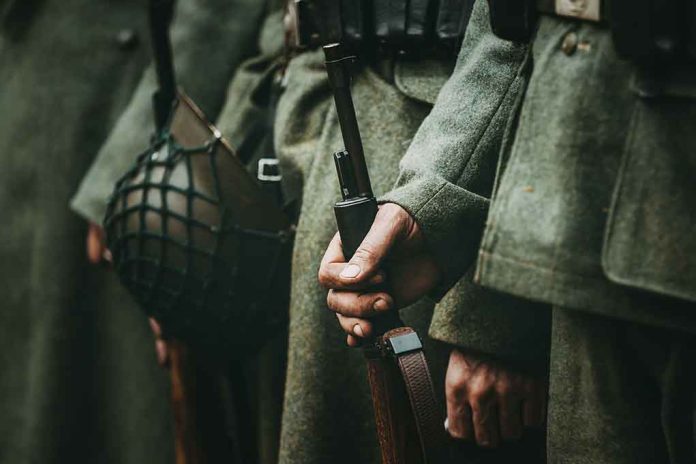
After 79 years, a fallen World War II hero’s remains are finally identified, bringing closure to his family and honoring his sacrifice.
At a Glance
- Army Private Jeremiah P. Mahoney, killed in 1945 in France, has been identified after nearly 80 years
- Advanced DNA analysis and forensic techniques enabled the identification of his remains
- Mahoney will be interred with full military honors at Arlington National Cemetery in 2025
- Over 72,000 Americans from World War II still remain unaccounted for
A Soldier’s Journey Home
In a testament to America’s commitment to leave no soldier behind, the remains of Army Private Jeremiah P. Mahoney have been identified nearly eight decades after his death in World War II. Mahoney, a 19-year-old soldier from Chicago, was killed in January 1945 during a German counteroffensive near Reipertswiller, France. His identification brings long-awaited closure to his family and highlights the nation’s ongoing efforts to account for all its fallen heroes.
Mahoney was part of an anti-tank company countering German forces when he met his untimely end. The circumstances of his death were recounted in a poignant letter to his mother, painting a vivid picture of the brutal realities of war.
“Shells were falling,” a soldier in the company later wrote to Private Mahoney’s mother in Chicago. “One came close and this fellow jumped into the foxhole on top of Mahoney. Then, at once, another one came in bursting in a tree, spraying shrapnel downward into his open half-finished hole.”
Following the war, Mahoney’s remains were discovered by French de-mining workers in 1947. However, due to technological limitations of the time, they could not be identified. In 1949, his remains were interred as “unknown” at the Ardennes American Cemetery in Belgium, where they remained for decades.
Breakthrough in Identification
The breakthrough in identifying Mahoney’s remains came through recent advancements in forensic techniques and DNA analysis. The Defense POW/MIA Accounting Agency, tasked with locating and identifying America’s missing service members, used these cutting-edge methods to match Mahoney’s remains with biological samples from living relatives.
Jerry Mannell, Mahoney’s nephew who never had the chance to meet his uncle, expressed a mix of emotions upon learning of the identification. “For the first time in my life, I had a familiarity with this long-lost uncle,” Mannell said. “There was a sense of closure and relief. But there was a larger sense of remorse for his immediate family not having this information before they passed.”
Army Pvt. Jeremiah Mahoney, 19, was among the 72,000 American soldiers still unaccounted for from WWII — until now. He will be buried at Arlington National Cemetery next spring, 100 years after he was born. https://t.co/rLMUq5G0sk
— jd mullane (@jdmullane) November 12, 2024
Honoring a Hero’s Sacrifice
Private Mahoney’s service record reveals a young man who answered his nation’s call with valor. He was part of Operation Dragoon and served in Italy and France, earning both the Bronze Star Medal and Purple Heart for his bravery and sacrifice. In a fitting tribute to his service, Mahoney will be laid to rest with full military honors at Arlington National Cemetery in 2025, coinciding with what would have been his 100th birthday.
“Kudos to the Army for sticking with this for 75 years,” Mr. Mannell said. “So they truly leave no soldier behind.”
The identification of Private Mahoney serves as a powerful reminder of the sacrifices made by the approximately 400,000 American service members who died in World War II. It also underscores the ongoing mission to account for the more than 72,000 Americans from that conflict who remain unlocated or unidentified.
As we reflect on Private Mahoney’s story, we are reminded of the enduring commitment to honor those who have given their lives in service to our nation. It stands as a testament to the fact that the passage of time does not diminish our duty to remember and respect the fallen, ensuring that their sacrifices are never forgotten.
Sources:
Army private who died in WWII identified almost 80 years after his death
Army Private Is Identified Almost 80 Years After Death in World War II
Army Private Is Identified Almost 80 Years After Death in World War II













